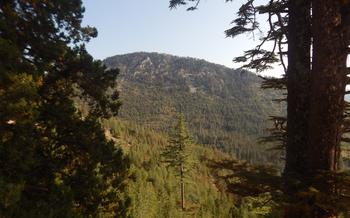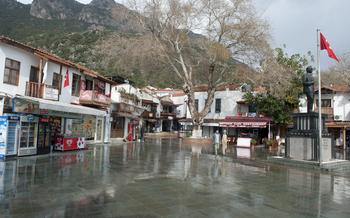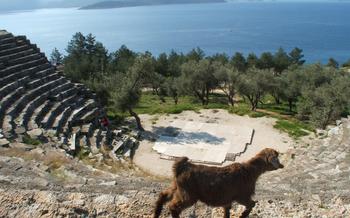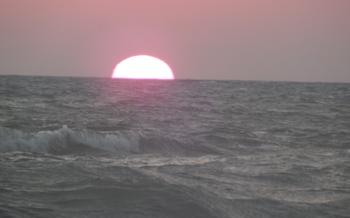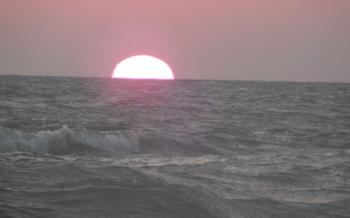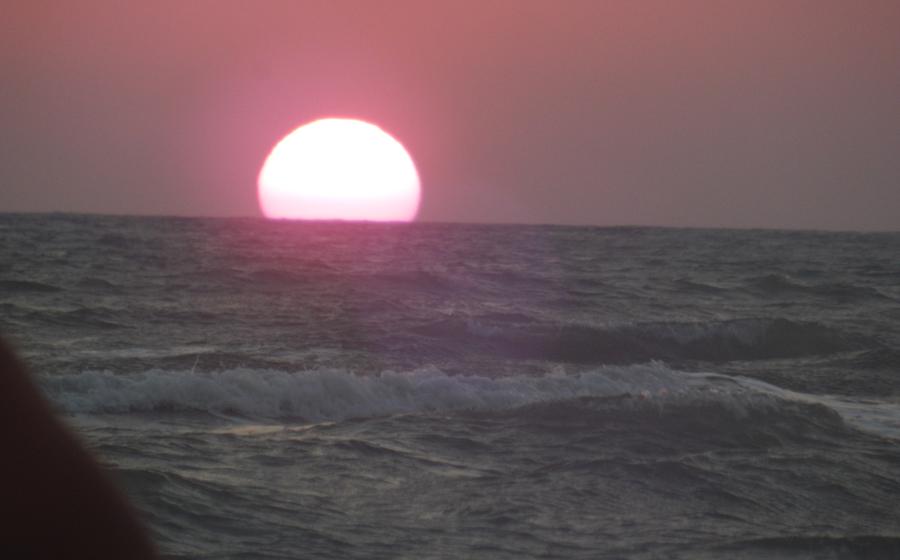
Kibris Gazi Wreck
- Historical Background
- Location and Accessibility
- Diving Conditions
- What to See
- Diving Permits and Regulations
- Dive Operators and Tours
- Cost of Diving
- Unique Features of the Wreck
- Guided Tours vs. Independent Diving
- Marine Life Encounters
- Best Time to Visit
- Insider Tip
Historical Background
In the depths of Kaş's crystal-clear waters lies the Kibris Gazi, a ship that has become an iconic symbol of Turkish maritime history. Built in 1953, this cargo vessel sailed the Mediterranean, carrying vital supplies between Turkey and the bustling ports of the Middle East. However, its journey took a fateful turn on January 22, 1976, when it struck a reef and sank just off the coast of Kaş.
The Kibris Gazi's tragic end not only marked a loss of life but also symbolized the challenges faced by Turkish seafarers navigating the treacherous waters of the Mediterranean. It stood as a testament to the sacrifices made by those who braved the high seas to ensure the flow of goods and commerce.
Today, the Kibris Gazi wreck serves as a poignant reminder of Turkey's rich maritime heritage. It has become a popular diving site, attracting enthusiasts from around the world who come to explore its depths and pay tribute to the memory of those who lost their lives.
Location and Accessibility
The Kibris Gazi wreck lies approximately 10 nautical miles southwest of Kaş, a charming coastal town on the Mediterranean coast of Turkey. The wreck rests on a sandy seabed at a depth of 30-35 meters, making it accessible to divers of various skill levels. To reach the wreck, you can either embark on a boat tour from Kaş harbor or join a private diving excursion organized by one of the local dive centers. These tours typically depart early in the morning and include multiple dives, allowing you to fully explore the wreck and the surrounding underwater world. If you're an experienced diver and prefer to explore independently, you can rent a boat and navigate to the wreck on your own. However, it's important to have a detailed map or GPS coordinates and to be aware of the local diving regulations and safety guidelines.
Diving Conditions
The diving conditions at the Kibris Gazi wreck are generally favorable, offering a rewarding experience for divers of all levels. The water temperature ranges from a comfortable 18-24 degrees Celsius (64-75 degrees Fahrenheit), making it suitable for year-round diving. The visibility underwater is typically excellent, allowing divers to enjoy clear views of the wreck and the surrounding marine life.
The currents around the wreck are generally mild, making it accessible to divers without extensive experience in strong currents. However, divers should be aware of the potential for occasional stronger currents, especially during certain weather conditions.
The depth of the wreck ranges from 18 to 30 meters (60 to 100 feet), making it suitable for both beginner and experienced divers. The shallower sections are ideal for novice divers, while the deeper areas offer a more challenging and rewarding experience for seasoned divers.
What to See
The Kibris Gazi wreck is a captivating underwater spectacle, revealing the remnants of a proud vessel that once sailed the seas. Measuring an impressive 110 meters in length, the wreck lies majestically on the seabed, its hull still largely intact. Exploring its depths, divers are greeted by a vibrant marine ecosystem that has made the wreck its home.
The wreck's exterior is adorned with a stunning array of corals, sponges, and anemones, creating a mesmerizing kaleidoscope of colors. In the surrounding waters, a diverse array of Mediterranean marine life thrives. Schools of colorful fish, including damselfish, sea bream, and moray eels, dart in and out of the wreck's crevices, adding life and movement to the scene.
Venturing inside the wreck is a thrilling experience for divers, offering a glimpse into the ship's past. The holds, once filled with cargo, now lie empty, a testament to the passage of time. Divers can explore the ship's cabins, engine room, and other compartments, discovering remnants of the ship's original fittings and fixtures.
The Kibris Gazi wreck is not only a fascinating dive site but also a poignant reminder of the rich maritime history of Turkey. It stands as a testament to the ingenuity and resilience of those who sailed these waters centuries ago, leaving behind a legacy that continues to captivate divers to this day.
Diving Permits and Regulations
Diving at the Kibris Gazi wreck, like any other underwater exploration in Turkey, requires adherence to specific regulations and permits. To ensure a safe and responsible diving experience, divers must obtain the necessary permits and follow established guidelines.
Before embarking on your dive, you must obtain a diving permit from the local authorities. This permit can be acquired through authorized dive centers or diving associations in Kaş. The permit process typically involves providing proof of diving certification and insurance, as well as paying a nominal fee.
Once you have obtained the necessary permit, it's crucial to familiarize yourself with the diving regulations and safety guidelines in place. These regulations are designed to protect both the environment and the safety of divers. They may include restrictions on diving depth, group size, and the use of certain equipment.
By adhering to these regulations and obtaining the required permits, you not only ensure your compliance with local laws but also contribute to the preservation of the Kibris Gazi wreck and its surrounding marine environment. Responsible diving practices help protect this unique underwater treasure for future generations of divers and marine enthusiasts to explore and appreciate.
Dive Operators and Tours
In Kaş, you'll find a range of reputable dive operators offering guided tours to the Kibris Gazi wreck. These operators ensure your safety and provide valuable insights into the wreck's history and marine life.
- Kaş Diving Center: Renowned for its experienced instructors and well-maintained equipment, Kaş Diving Center offers guided dives suitable for divers of all levels.
- Octopus Diving: Known for its small group sizes and personalized attention, Octopus Diving provides a tailored diving experience, catering to your specific interests and skill level.
- Blue World Diving: If you're seeking a dive operator that emphasizes environmental conservation, Blue World Diving is an excellent choice, actively promoting responsible diving practices.
Regarding dive tours, you'll find a variety of options to suit your preferences:
- Guided Dives: Ideal for beginners or those seeking a structured experience, guided dives are led by experienced instructors who ensure your safety and provide informative commentary throughout the dive.
- Night Dives: For a truly unique experience, consider a night dive to witness the nocturnal marine life that emerges after sunset.
- Photography Dives: If you're passionate about underwater photography, opt for a photography-specific dive tour, where you'll receive guidance on capturing stunning images of the wreck and its surroundings.
Before embarking on your dive, be sure to discuss your experience level, interests, and any specific requests with the dive operator to ensure they can provide the most suitable tour for you.
Cost of Diving
The cost of a guided dive to the Kibris Gazi wreck can vary depending on the dive operator, the type of tour, and the number of divers in the group. On average, you can expect to pay around 30-50 euros for a single dive, including equipment rental.
Additional charges may apply for permits and insurance, as well as for specialized equipment such as underwater cameras or nitrox tanks. It's important to inquire about these additional costs when booking your dive to avoid any surprises.
To save money, consider booking a package that includes multiple dives or opting for a group discount. Many dive operators also offer discounts for students, military personnel, and seniors.
Unique Features of the Wreck
The Kibris Gazi wreck stands out among the many historical shipwrecks in Turkey due to several distinctive characteristics. One remarkable feature is its size and structure. The ship's massive hull, measuring approximately 120 meters in length and 20 meters in width, creates an imposing underwater presence. Divers can explore the ship's various sections, including the engine room, holds, and cabins, gaining insights into the vessel's design and layout.
Another unique aspect of the Kibris Gazi is its historical significance. The ship played a prominent role in the Turkish War of Independence (1919-1923) as a cargo vessel transporting supplies and ammunition to Turkish forces. Its sinking during a fierce battle against Greek warships symbolizes the sacrifices made by Turkish sailors in the struggle for independence, making it a poignant reminder of the country's maritime history.
Furthermore, the Kibris Gazi wreck has become a haven for marine life, creating a vibrant and diverse underwater ecosystem. The ship's hull, covered in colorful coral formations and encrusted with sponges, provides a habitat for a wide range of marine species. Divers can encounter friendly groupers, graceful rays, playful dolphins, and a myriad of colorful fish darting in and out of the wreck's nooks and crannies.
The Kibris Gazi wreck offers a unique blend of history, adventure, and marine life encounters, making it a must-visit destination for divers and history enthusiasts alike. Exploring this iconic wreck provides a glimpse into Turkey's rich maritime heritage while immersing oneself in the wonders of the underwater world.
Guided Tours vs. Independent Diving
Whether you choose to embark on a guided tour or venture into the depths independently depends on your experience level, comfort in the water, and budget.
Guided Tours:
- Advantages:
- Safety: Experienced guides ensure your safety by monitoring dive conditions, providing navigation assistance, and responding to emergencies.
- Knowledge: Guides share their expertise about the wreck's history, marine life, and optimal dive routes.
-
Convenience: Guided tours take care of logistics, including boat transportation, equipment rental, and permits.
-
Disadvantages:
- Cost: Guided dives tend to be more expensive than independent diving.
- Flexibility: Tours operate on a fixed schedule, limiting your freedom to explore at your own pace.
- Group dynamics: Diving with a group may not suit everyone's preferences or skill levels.
Independent Diving:
- Advantages:
- Flexibility: Dive at your own pace, choose your dive sites, and spend as much time as you want exploring the wreck.
-
Cost-effective: Avoid tour fees by renting equipment locally and obtaining permits independently.
-
Disadvantages:
- Safety: Requires a higher level of experience and self-sufficiency in navigation, emergency response, and problem-solving.
- Knowledge: You may miss out on valuable insights and historical information provided by experienced guides.
- Logistics: Arranging boat transportation, permits, and equipment rental can be time-consuming and challenging.
Marine Life Encounters
The Kibris Gazi wreck has become a haven for a diverse array of marine life, creating a vibrant underwater ecosystem. Divers can expect to encounter a variety of fish species, including colorful damselfish, groupers, sea bass, and tuna. The wreck also attracts larger pelagic species such as barracuda, rays, and even the occasional shark.
Divers should be mindful of the marine life they encounter and avoid disturbing or touching any creatures. It is important to maintain a respectful distance and observe the animals in their natural habitat. Photography is permitted, but divers should be mindful not to use flash or bright lights, which can disrupt or harm the marine life.
By following responsible diving practices and adhering to local regulations, divers can help preserve the delicate marine ecosystem that has developed around the Kibris Gazi wreck. This will ensure that future generations can continue to enjoy the wonders of this underwater treasure.
Best Time to Visit
The best time to visit the Kibris Gazi wreck for diving is during the summer months, from May to October. During this period, the weather is generally stable, with warm temperatures and clear visibility. The water temperature ranges from 20 to 26 degrees Celsius, providing comfortable conditions for divers.
The summer months also offer the best visibility, with an average of 20 to 30 meters. This allows divers to fully appreciate the wreck's intricate details and the vibrant marine life surrounding it.
However, it's important to note that the summer months are also the peak tourist season in Kaş. This means that the dive sites can be crowded, and it's advisable to book your diving tour in advance to avoid disappointment.
If you're looking for a more secluded experience, consider visiting during the shoulder months of April and November. The weather is still generally favorable, but the crowds are smaller, and you may have the opportunity to enjoy the wreck with fewer divers around.
Keep in mind that diving conditions can change rapidly, even during the summer months. It's essential to check the weather forecast and consult with local dive operators before planning your dive to ensure the safety and quality of your experience.
Insider Tip
Secret Spots and Hidden Gems:
Beyond the main wreck, there are several hidden gems worth exploring for seasoned divers. The nearby rock formations and crevices often harbor diverse marine life, including rare species of nudibranchs and scorpionfish. Explore the surrounding area to discover these secret spots and capture unique underwater shots.
Tips for Capturing Unique Underwater Shots:
To capture stunning underwater photos at the Kibris Gazi wreck, consider using a wide-angle lens to capture the grandeur of the wreck alongside the surrounding marine life. Experiment with different angles and perspectives to create dynamic compositions. Use natural light to your advantage, and adjust your camera settings accordingly to achieve optimal exposure and color balance. Patience is key – take your time to observe the wreck and its inhabitants, waiting for the perfect moment to capture that special shot.
